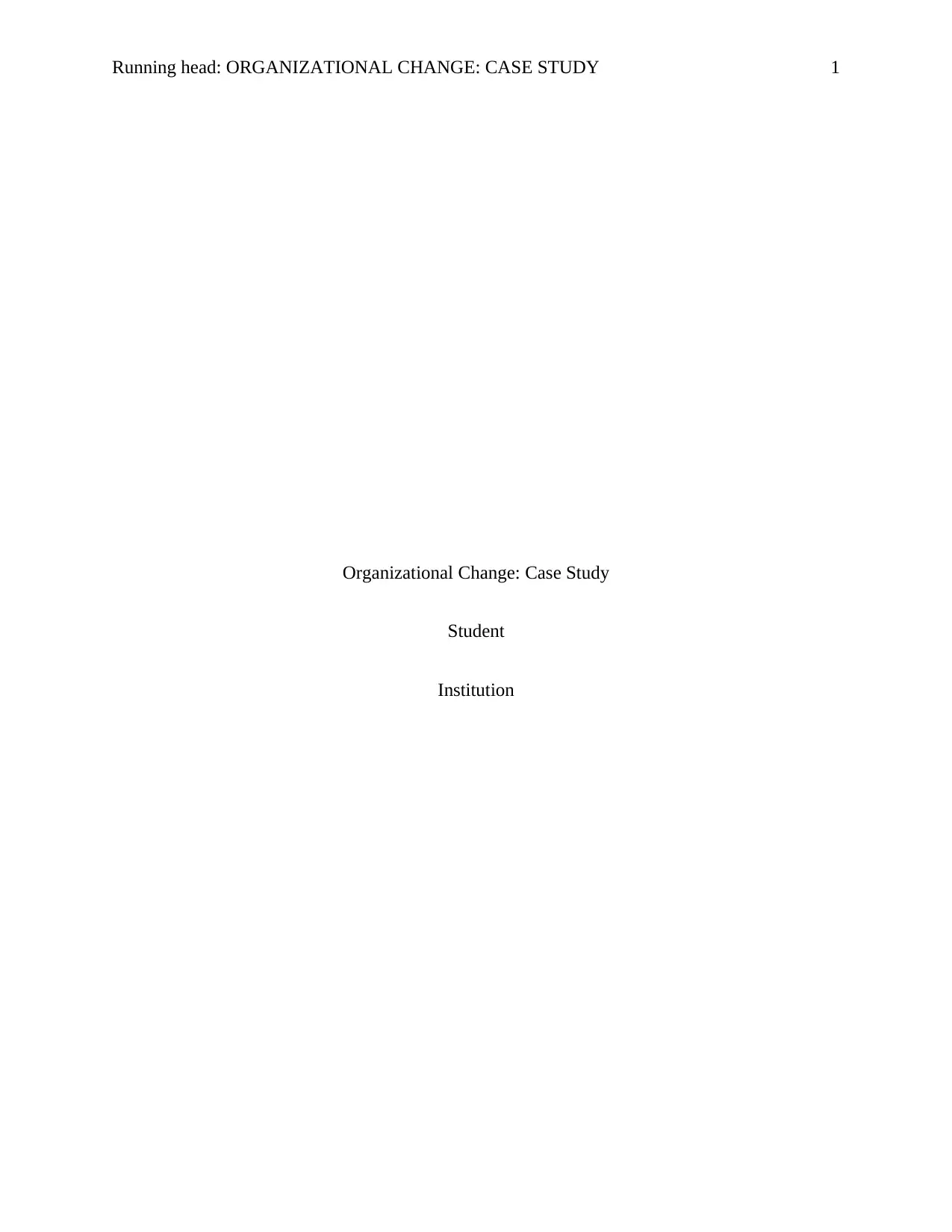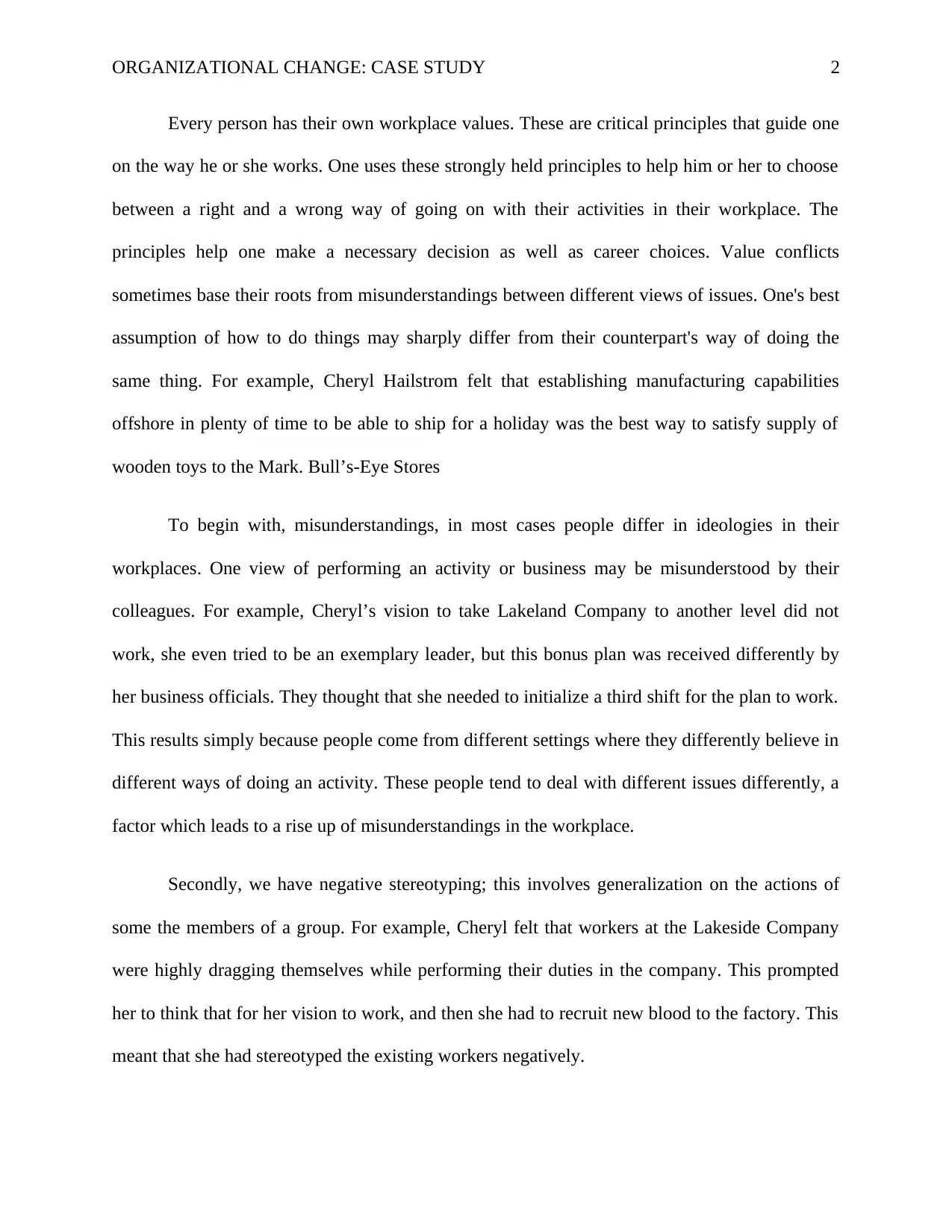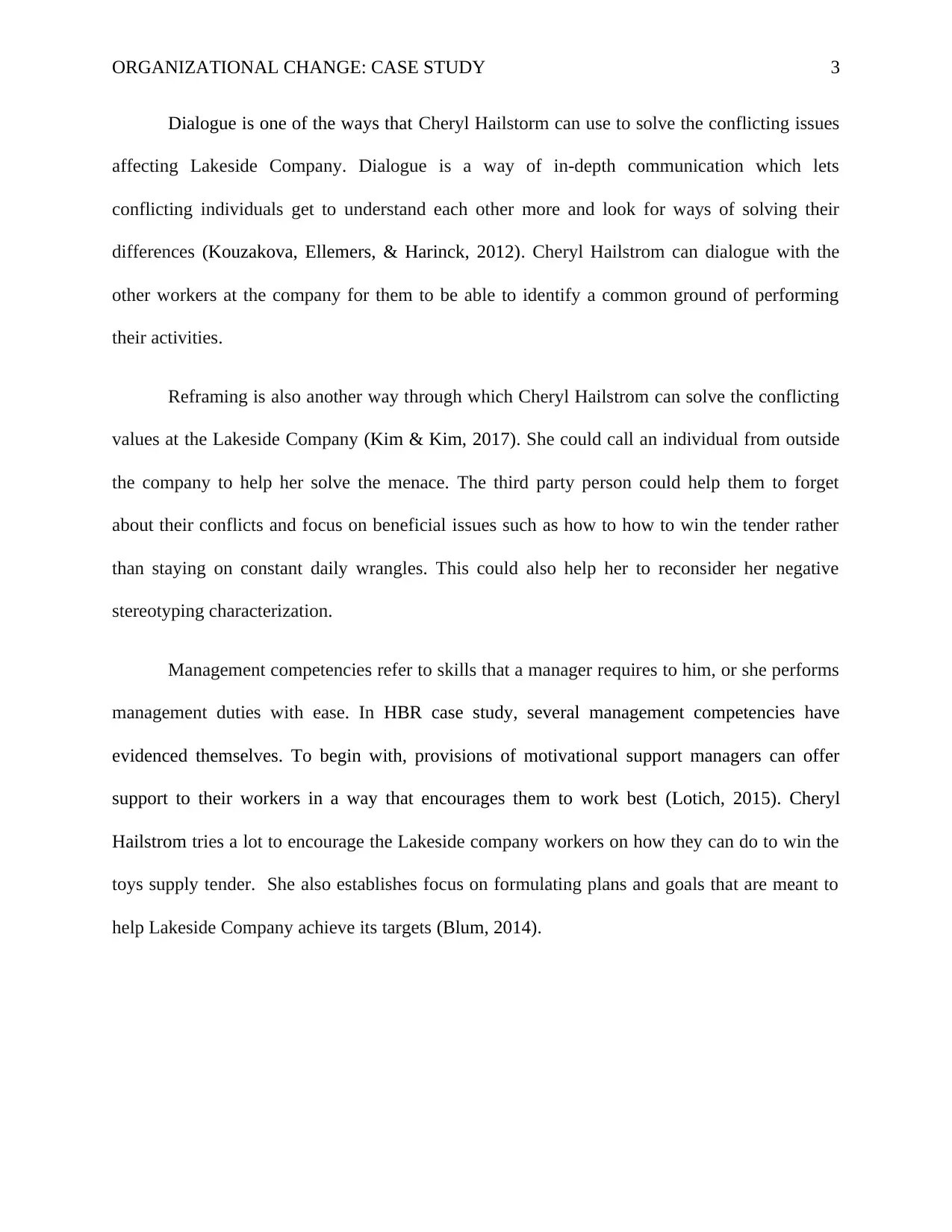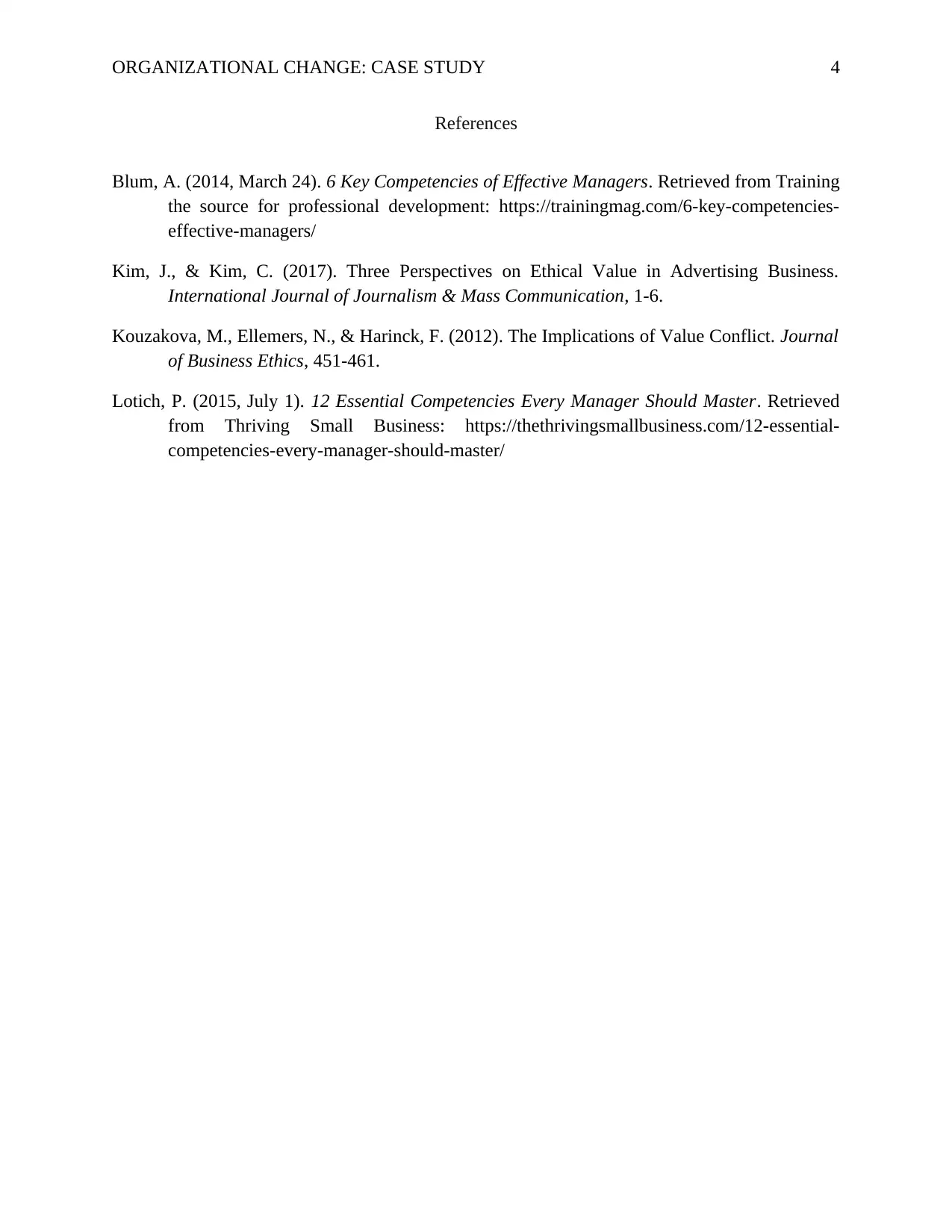Organizational Change and Leadership: Lakeland Wonders Case Study
VerifiedAdded on 2023/06/11
|4
|788
|376
Case Study
AI Summary
This case study examines the challenges of organizational change at Lakeland Wonders following the appointment of a new CEO, Cheryl Hailstrom. It highlights the value conflicts arising from differing workplace ideologies and negative stereotyping. The solution proposes dialogue and reframing as conflict resolution strategies. Furthermore, it identifies key management competencies, such as motivational support and goal formulation, demonstrated by Cheryl in her attempts to lead the company. The analysis references relevant academic sources to support its arguments and recommendations. Desklib offers students access to this and many other solved assignments to aid in their studies.

Running head: ORGANIZATIONAL CHANGE: CASE STUDY 1
Organizational Change: Case Study
Student
Institution
Organizational Change: Case Study
Student
Institution
Paraphrase This Document
Need a fresh take? Get an instant paraphrase of this document with our AI Paraphraser

ORGANIZATIONAL CHANGE: CASE STUDY 2
Every person has their own workplace values. These are critical principles that guide one
on the way he or she works. One uses these strongly held principles to help him or her to choose
between a right and a wrong way of going on with their activities in their workplace. The
principles help one make a necessary decision as well as career choices. Value conflicts
sometimes base their roots from misunderstandings between different views of issues. One's best
assumption of how to do things may sharply differ from their counterpart's way of doing the
same thing. For example, Cheryl Hailstrom felt that establishing manufacturing capabilities
offshore in plenty of time to be able to ship for a holiday was the best way to satisfy supply of
wooden toys to the Mark. Bull’s-Eye Stores
To begin with, misunderstandings, in most cases people differ in ideologies in their
workplaces. One view of performing an activity or business may be misunderstood by their
colleagues. For example, Cheryl’s vision to take Lakeland Company to another level did not
work, she even tried to be an exemplary leader, but this bonus plan was received differently by
her business officials. They thought that she needed to initialize a third shift for the plan to work.
This results simply because people come from different settings where they differently believe in
different ways of doing an activity. These people tend to deal with different issues differently, a
factor which leads to a rise up of misunderstandings in the workplace.
Secondly, we have negative stereotyping; this involves generalization on the actions of
some the members of a group. For example, Cheryl felt that workers at the Lakeside Company
were highly dragging themselves while performing their duties in the company. This prompted
her to think that for her vision to work, and then she had to recruit new blood to the factory. This
meant that she had stereotyped the existing workers negatively.
Every person has their own workplace values. These are critical principles that guide one
on the way he or she works. One uses these strongly held principles to help him or her to choose
between a right and a wrong way of going on with their activities in their workplace. The
principles help one make a necessary decision as well as career choices. Value conflicts
sometimes base their roots from misunderstandings between different views of issues. One's best
assumption of how to do things may sharply differ from their counterpart's way of doing the
same thing. For example, Cheryl Hailstrom felt that establishing manufacturing capabilities
offshore in plenty of time to be able to ship for a holiday was the best way to satisfy supply of
wooden toys to the Mark. Bull’s-Eye Stores
To begin with, misunderstandings, in most cases people differ in ideologies in their
workplaces. One view of performing an activity or business may be misunderstood by their
colleagues. For example, Cheryl’s vision to take Lakeland Company to another level did not
work, she even tried to be an exemplary leader, but this bonus plan was received differently by
her business officials. They thought that she needed to initialize a third shift for the plan to work.
This results simply because people come from different settings where they differently believe in
different ways of doing an activity. These people tend to deal with different issues differently, a
factor which leads to a rise up of misunderstandings in the workplace.
Secondly, we have negative stereotyping; this involves generalization on the actions of
some the members of a group. For example, Cheryl felt that workers at the Lakeside Company
were highly dragging themselves while performing their duties in the company. This prompted
her to think that for her vision to work, and then she had to recruit new blood to the factory. This
meant that she had stereotyped the existing workers negatively.

ORGANIZATIONAL CHANGE: CASE STUDY 3
Dialogue is one of the ways that Cheryl Hailstorm can use to solve the conflicting issues
affecting Lakeside Company. Dialogue is a way of in-depth communication which lets
conflicting individuals get to understand each other more and look for ways of solving their
differences (Kouzakova, Ellemers, & Harinck, 2012). Cheryl Hailstrom can dialogue with the
other workers at the company for them to be able to identify a common ground of performing
their activities.
Reframing is also another way through which Cheryl Hailstrom can solve the conflicting
values at the Lakeside Company (Kim & Kim, 2017). She could call an individual from outside
the company to help her solve the menace. The third party person could help them to forget
about their conflicts and focus on beneficial issues such as how to how to win the tender rather
than staying on constant daily wrangles. This could also help her to reconsider her negative
stereotyping characterization.
Management competencies refer to skills that a manager requires to him, or she performs
management duties with ease. In HBR case study, several management competencies have
evidenced themselves. To begin with, provisions of motivational support managers can offer
support to their workers in a way that encourages them to work best (Lotich, 2015). Cheryl
Hailstrom tries a lot to encourage the Lakeside company workers on how they can do to win the
toys supply tender. She also establishes focus on formulating plans and goals that are meant to
help Lakeside Company achieve its targets (Blum, 2014).
Dialogue is one of the ways that Cheryl Hailstorm can use to solve the conflicting issues
affecting Lakeside Company. Dialogue is a way of in-depth communication which lets
conflicting individuals get to understand each other more and look for ways of solving their
differences (Kouzakova, Ellemers, & Harinck, 2012). Cheryl Hailstrom can dialogue with the
other workers at the company for them to be able to identify a common ground of performing
their activities.
Reframing is also another way through which Cheryl Hailstrom can solve the conflicting
values at the Lakeside Company (Kim & Kim, 2017). She could call an individual from outside
the company to help her solve the menace. The third party person could help them to forget
about their conflicts and focus on beneficial issues such as how to how to win the tender rather
than staying on constant daily wrangles. This could also help her to reconsider her negative
stereotyping characterization.
Management competencies refer to skills that a manager requires to him, or she performs
management duties with ease. In HBR case study, several management competencies have
evidenced themselves. To begin with, provisions of motivational support managers can offer
support to their workers in a way that encourages them to work best (Lotich, 2015). Cheryl
Hailstrom tries a lot to encourage the Lakeside company workers on how they can do to win the
toys supply tender. She also establishes focus on formulating plans and goals that are meant to
help Lakeside Company achieve its targets (Blum, 2014).
⊘ This is a preview!⊘
Do you want full access?
Subscribe today to unlock all pages.

Trusted by 1+ million students worldwide

ORGANIZATIONAL CHANGE: CASE STUDY 4
References
Blum, A. (2014, March 24). 6 Key Competencies of Effective Managers. Retrieved from Training
the source for professional development: https://trainingmag.com/6-key-competencies-
effective-managers/
Kim, J., & Kim, C. (2017). Three Perspectives on Ethical Value in Advertising Business.
International Journal of Journalism & Mass Communication, 1-6.
Kouzakova, M., Ellemers, N., & Harinck, F. (2012). The Implications of Value Conflict. Journal
of Business Ethics, 451-461.
Lotich, P. (2015, July 1). 12 Essential Competencies Every Manager Should Master. Retrieved
from Thriving Small Business: https://thethrivingsmallbusiness.com/12-essential-
competencies-every-manager-should-master/
References
Blum, A. (2014, March 24). 6 Key Competencies of Effective Managers. Retrieved from Training
the source for professional development: https://trainingmag.com/6-key-competencies-
effective-managers/
Kim, J., & Kim, C. (2017). Three Perspectives on Ethical Value in Advertising Business.
International Journal of Journalism & Mass Communication, 1-6.
Kouzakova, M., Ellemers, N., & Harinck, F. (2012). The Implications of Value Conflict. Journal
of Business Ethics, 451-461.
Lotich, P. (2015, July 1). 12 Essential Competencies Every Manager Should Master. Retrieved
from Thriving Small Business: https://thethrivingsmallbusiness.com/12-essential-
competencies-every-manager-should-master/
1 out of 4
Related Documents
Your All-in-One AI-Powered Toolkit for Academic Success.
+13062052269
info@desklib.com
Available 24*7 on WhatsApp / Email
![[object Object]](/_next/static/media/star-bottom.7253800d.svg)
Unlock your academic potential
Copyright © 2020–2025 A2Z Services. All Rights Reserved. Developed and managed by ZUCOL.



